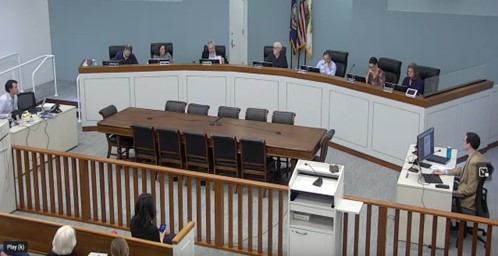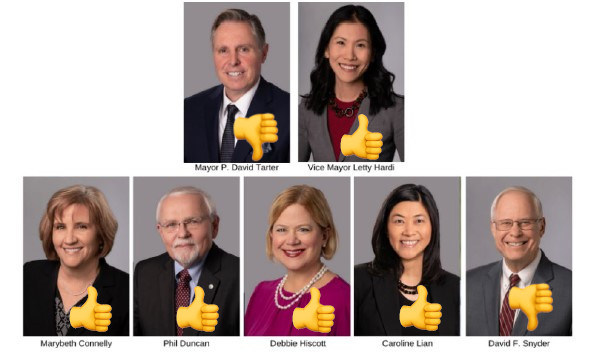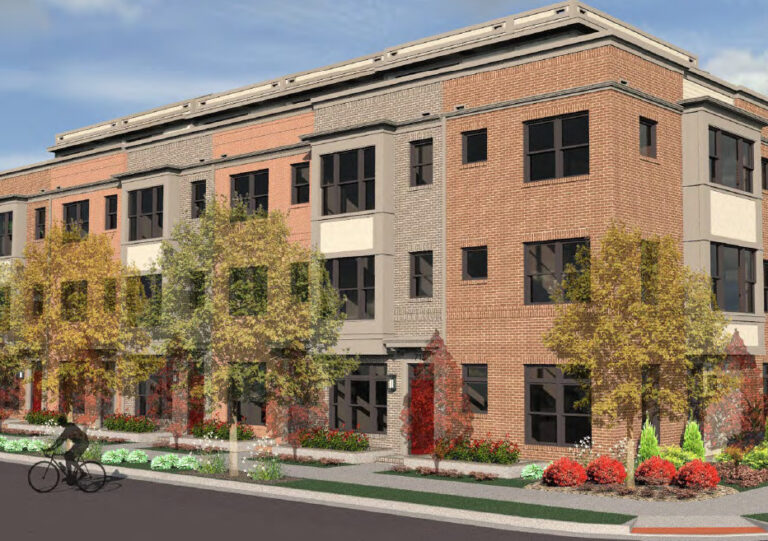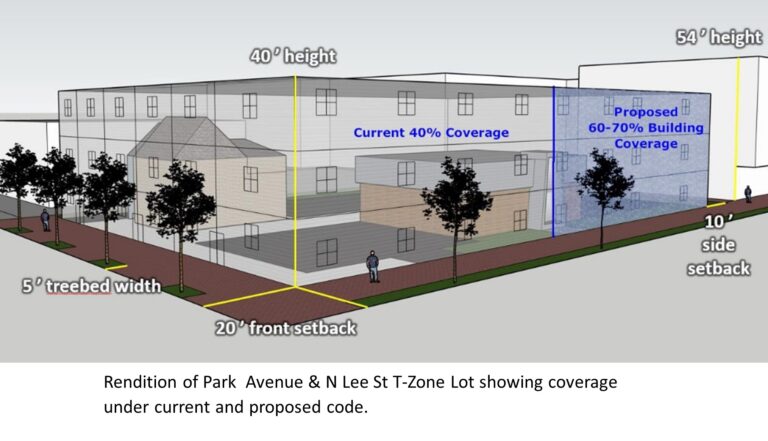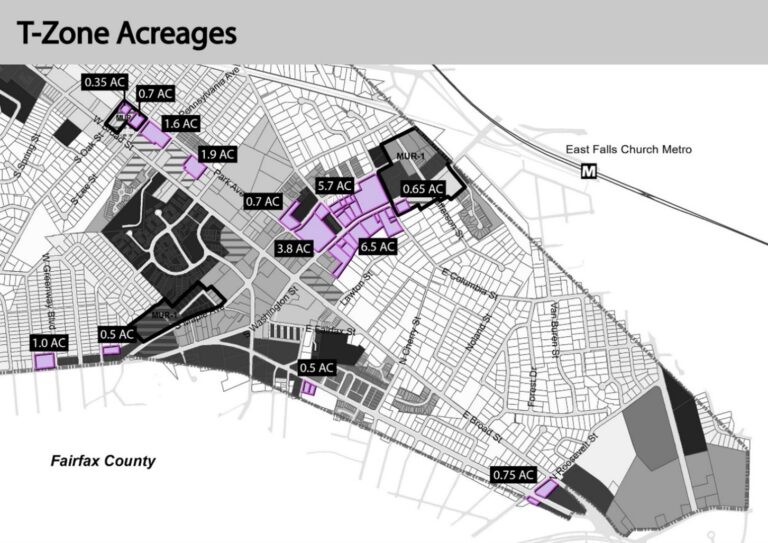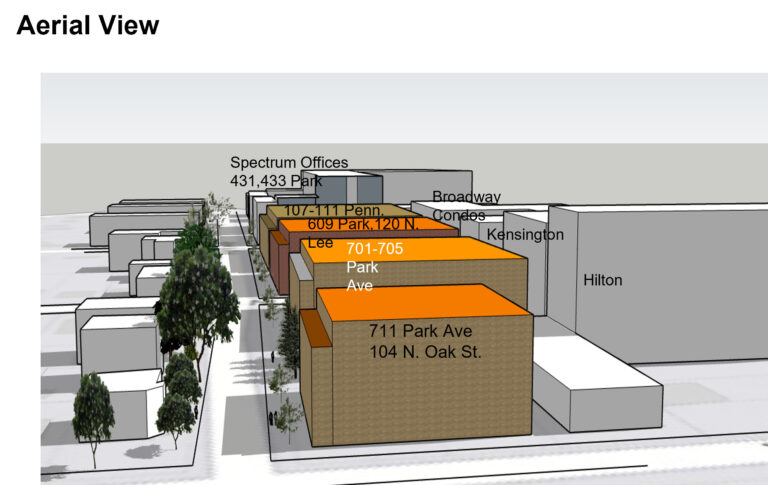Planning Commission Shows Deference To Developers
On February 15, the Planning Commission approved recommendations to the City Council on amendments to transition zones based on eleventh-hour demands from four developers and the Falls Church Chamber of Commerce, see Developers’ Letters post, to allow more building, challenge minimal setbacks, and provide weaker environmental protections. The proposed code was weakened by allowing developers to apply for Special Use Permits (SUPs) to increase height and lot coverages and reduce front and rear setbacks.
In making these recommendations, the Commission ignored the carefully considered opposition and alternatives it received from more than 100 knowledgeable citizens.
Video clip 1. Commissioners discuss what lot coverages developers want
Video clip 2. Commissioners discuss giving developers flexibility to reduce setbacks
Full length video available here.
Transcript of Video Clip 1 (Edited for readability)
Caumont: On the building lot coverage, we had two suggestions to increase that to 70%. Is that something that we want to discuss?
Krasner: Yeah, I was going to flag that that issue. We heard, I mean if people look at our comments, I mean, I heard from several Commissioners they wanted to hear from the development community. We got about half a dozen letters from the development community in our package. They all flag that as a potential stumbling block to producing anything beyond townhouses, so if folks want to encourage more than just townhouses and, you know, including, you know, some of these small multi-family, we might need maybe by sup they can go higher? I mean, I think we need to provide some opportunity to go higher than that.
Stevens: I think I’m seeing a lot of positive head nods so that’s certainly within the range of what, you know, I could live with. If we want to change the 60 to 70?
Friedlander: I think again this comes to the decoupling of Park Avenue T-zones from North Washington. I think in North Washington I’m in complete support of that. I think when you’re transitioning from Broad Street and down Park, I don’t think you’ll be able to get your tree canopy if you’re at 70%. I mean I that’s why I think it and maybe those those two zones need to be addressed separately in that lot coverage.
Stevens: Any reaction?
Puentes: If we have both requirements in, and developers can do it, then, right, maybe encourage them to be more creative about their tree canopy, which I agree needs to be in there for sure.
Stevens: Mr. Stoddard, do you see a problem with having a split coverage between Park Avenue and North Washington in our recommendation back to Council?
Stoddard: Well, you’ve got your uses split. As sort of written, you’ve got your uses split, you know, North Washington Park Avenue, other t-zones. It should be possible to structure sort of a limit- different lot coverage limits differently based on the different districts. The one thing you might want to do, obviously there is going to be additional engagement on this even before it gets to the first reading, maybe this is something you sort of ask them to sort of give another look to and say “Look, we you know we think it should be somewhere between these two numbers”. Some way of signaling –
Krasner: They recommended 80. I mean, right, they recommend – the council recommended to us 80, right? Initially we kind of felt like maybe that was too much.
Stevens: Starting out at 40
Krasner: Yeah, so yeah, I don’t know – that’s why I’m saying if it’s by special permit, then I mean folks have to demonstrate that and there’s oversight over the design and balancing competing interests like tree canopy and other things. I just think if you want to see like a, you know, like for example a four-unit type of thing on Park, which I wouldn’t be opposed to something on that scale. I mean I don’t think we want to see a large multi-family but, you know, 60 might be a little tight. Some of the lots are very small. So without consolidation, I mean without like significant consolidation, which might be difficult, I’m concerned that without some ability to go higher it could become an issue. It’s based on what we heard from folks who, you know, are building that. So that was the reason I flagged it. Initially I think I was very keen on the 60 number but, you know, we seem to get some feedback from the development community that that might be a might be an issue.
Stoddard: Just to suggest that – sorry to interrupt – but what you might be able to use is the same construction that’s proposed for? where you would set a by right lot coverage limit of 60, and then with an SUP, you could allow for a higher lot coverage because, of course, the SUP does allow for design controls and design review.
Stevens: Can you construct some language to add there that sounds agreeable to me?
Stoddard: Sure. I think what you would say is sort of set the maximum by right- the maximum by right building lot coverage is 60 percent, with an allowance at the maximum lot coverage for conditional uses SUPs up to – I think it’s sort of how you all weigh the comments coming in, the comment letters about what number you want to put in.
Krasner: It seemed like 70 was – I know some people, I mean I’m sure there are folks that would want to build, you know, who want to build would say they want more but it seemed like 70 was where were some consensus in the comments. That at least 70 would provide more flexibility. And if it’s under SUP, again, there’s still a lot of oversight in allowing that, I mean. It just means that they’re permitted to ask for that much doesn’t mean you automatically get it. But it allows someone to come in with a design up to that level and then it gets evaluated to see if it works. But if it’s not in there as an option, then there that’s it. Then they’re capped, and, you know, we wouldn’t have the ability to allow more under any circumstance.
Stevens: Is there some additional language then on that?
Stoddard: Yeah, so I think you might be set a maximum by right building lot coverage of 60% and a maximum conditional building lot coverage of- I think the number I heard was 70. I’m being very cautious about that number because I don’t want to be putting words in the in the commissioners’ mouths.
Krasner: That’s right, that’s what I said. If other folks agree with that. That’s what I said.
Weiss: I’ll chime in and say I agree with that. I support the principal. I just I’m still uncomfortable with the 60 versus 70 versus 75 percent. It feels a little bit like grasping at straws, and reading through the developer comments – a handful said that but a handful said otherwise.
Stevens: That’s right, and I think we need additional time to absorb those comments. And, as someone said, to see some illustrations of what would come about from that. That’s not going to happen this evening. So I think we’re just trying to launch this thing, and at least try to share with Council that you know 60 was not a scientific number. It’s not something that we feel is a hard stake in the ground. They may in their wisdom look at it a little differently. I don’t think that would cause any problems with us.
Transcript of Video Clip 2 (Edited for readability)
Weiss: I guess I do have a comment on the discussion of the motion because I do feel like we currently have t-zone’s where there’s very little development happening, and I don’t know if we’re gonna move the needle with us, and so I guess is there a way for us, like your comment about increasing the front setback, I don’t know the right answer to that. We’ve seen some comments from developers saying that the setbacks, just the rear setbacks are deal killers. Are they? I don’t know, so I don’t know if it’s the right answer. I don’t know if it’s the wrong answer, right?
Friedlander:I don’t think we’re going to come to that conclusion here. I think it warrants more development and more study of what truly is feasible. I would like to see the numbers of that, rather than a few letters that say “Absolutely, it needs to be greater, it needs to be greater.” Of course, everybody wants it to be greater if you’re developing it. I get that, but I think feasibility needs to be shown.
Weiss: In many of our recommendations to council we have made specific recommendations beyond the ‘whereas’, can we add a recommendation to consider, what’s the word that you, the phrasing that you were using? Look at the look at the massing and the setbacks and how that pencils out feasibly, economically.
Friedlander: Yes, it’s the difference 60 versus 70 versus 80. Or 60 versus 70 if that’s what’s in there.
Stoddard: If I could just procedurally what I would suggest is that at this point there is a motion on the table and so what I would suggest is that if there’s a desire to change it I would suggest that you propose an amendment and then if it’s accepted by the first and the second then it becomes a friendly Amendment if it’s not accepted then it goes to a vote of the group about whether to include it or not.
Weiss: Well, that’s why I was asking if there was any discussion on the motion because we went straight to the vote and missed it.
Stoddard: So I think amendments to the motion is appropriate this time.
Weiss: Yeah. I would actually defer to my colleague commissioner Friedlander, is that something that you would – that’s a second a friendly amendment that I’d like to propose but I think you phrase it much better than I do. If it makes sense to you as an amendment. If it doesn’t then I’ll –
Friedlander: It does make sense if it actually secures that with City Council and City staff to do that, we can certainly add that here. I’m not opposed to that.
Stevens: Do you have a specific proposal that we can –
Weiss: I would like to propose a friendly Amendment in collaboration with commissioner Friedlander – can you scooch up please? Where was it?
Friedlander: We recommend reevaluation of massing proposals set forth in this -I don’t know how to say it myself.
Caumont: Could you say something like increase the rear and front setback requirements to 20 feet provided this does not make projects infeasible?
Krasner: It gets kind of subjective.
Caumont: Are you just asking for them to study it? Is that what you want to include?
Krasner: I mean there was some massing. Staff provided some basic massing of the 80 percent, and the height, early on, like months ago.
Friedlander: That’s a diagrammatic model. I don’t think that was –
Krasner: There’s a big range of lot sizes in the T-Zone. So all the different T-Zone lots – we have some very small ones we got some large ones.
Hyra: Can I jump in just real quick, hopefully. I recommend that we don’t tweak this because we need to set something. Right? And you’re asking will it work or will it not work. Well, do you know what the cost of capital is going to be? Do we know what land is going to be? I mean that’s what affects the pro forma. Set what we think is right, what we want, and let developers figure out they can do it or not, because whether it’s feasible – even the comments we got from developers, that’s based on capital today. We don’t know if the feds are going to raise interest rates or lowest interest rates, which will change the proforma completely. So you’re asking for things that I think it’s good for you to ask, but we don’t have the answers, nor do developer and the market conditions will change. So set what you want. Don’t worry about feasibility for the developers. Don’t.
Krasner: Yeah, and that’s why baking in some flexibility is good. So I kind of like how we arrived at a compromise, on a) where we have 60 but it’s conditional, you know, by SUP you can go higher. I mean, it’s true. It’s hard for us to sit here and prescribe development regulations across a very disparate set of conditions from Park Avenue to Washington Street to other areas where the t-zones are. So I agree. I don’t know if 20 ft is the right number on Park. It may be too much. I don’t know, or maybe not. But I think it depends lot by lot. So I don’t know. I mean, I think it’s hard for us to be so sure. I would admit that I think it’s really gonna be difficult for us to sit here today and prescribe the bulk standards and know for sure those are right. Because right now they’re look at existing townhouses along Park, and existing residential on Park, there’s a big range of setback. The single-family houses on the north side of course have the R1 B setbacks, but then some of the townhouses on the south side have a much smaller setback than 20 feet. So I don’t know.
Stevens: I think I’m hearing sympathy for the concept but not quite sure how?
Caumont: I have an idea. Can we just include the same flexibility for the setbacks that we have for the lot coverage – so increase the rear and front setback requirements to 20 feet and then you have a conditional ability for a minimum of 10. I agree with you, Brent, that I like that, because not every situation is the same, and so having that flexibility makes sense.
Hyra: But make sure it’s not by right.
Krasner: They have to go through a special permit process. They can ask for a reduction in that.
Caumont: Is that your friendly Amendment?
Weiss: That’s my friendly Amendment.

